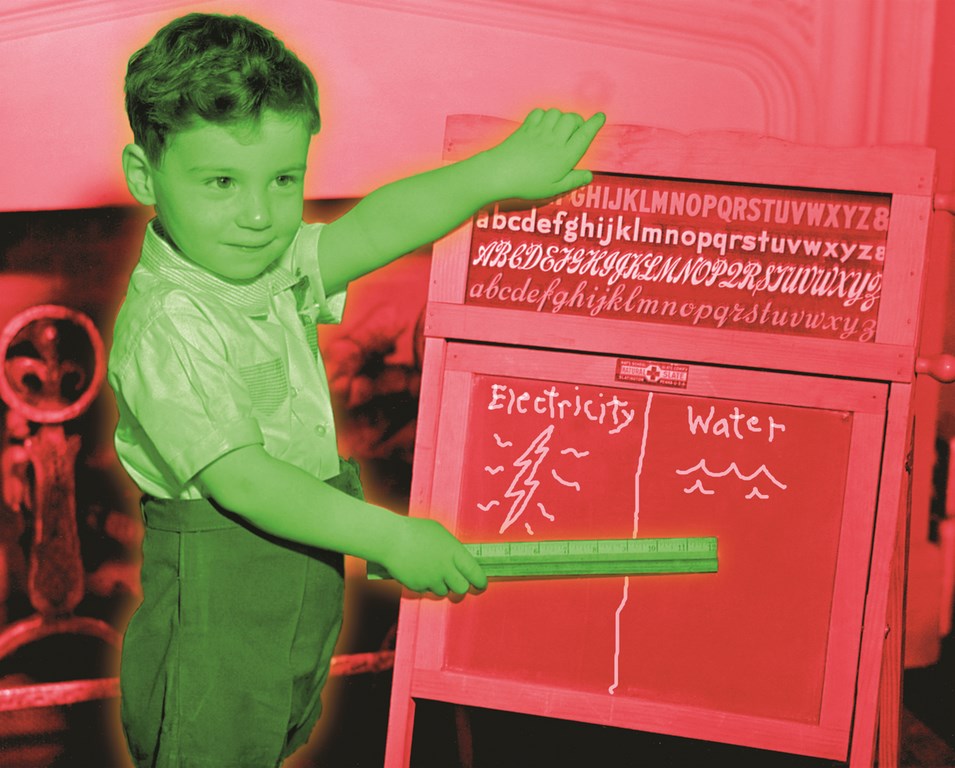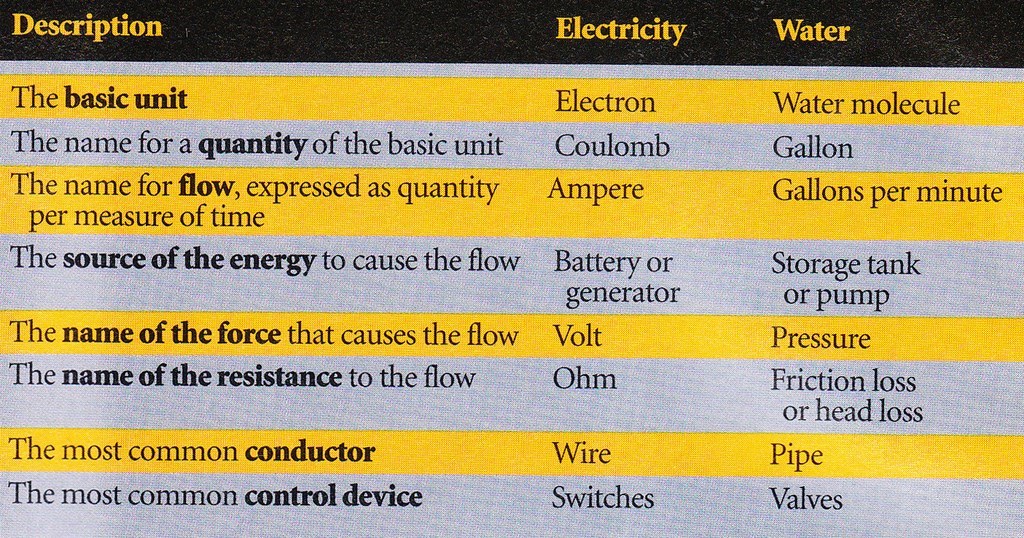Easier by Analogy

Several years ago, I was asked to conduct a seminar on basic electricity for the members of a small homeowners’ association. They were working their way alphabetically through the various trade disciplines with which a homeowner might come in contact. As I recall, they had covered attic fans, brickwork, cabinetry, carpeting, decks and doors at previous meetings. I learned that I was to be followed in coming months by fences, fireplaces and gazebos. Kinda puts one in one’s place.
I started off by advising the good folk that electricity isn’t that difficult to understand if we examine it in terms of something with which we are a bit more familiar, such as the movement of water. I promised them that by using the simple (yet elegant) comparison of the flow of water in pipes to the flow of electric current in wires, I would have them all on easy speaking terms with the subject in no time at all.
Within three minutes I was in deep trouble: When I talked about a centrifugal pump pushing the water, a gentleman asked how a pump worked. When I described water flowing through a pipe, I was asked why more water flowed through a big pipe than through a small one. We went down several avenues, roads, paths and alleys, but somehow I always managed to drag ’em back to things electric.
EASIER PATHWAYS
Obviously (and thankfully), these are not the sort of questions I get when describing electricity to members of the watershaping industry. And that simplifies the task considerably, because the water-flow/electric-current-flow analogy is a very good and appropriate way of getting comfortable with the interrelationship of amps, volts and ohms.
Let’s see if I can put a slightly different twist to this than you may have seen in the past.
Before describing the similarities between the water current and the electric current, however, permit me to point out two very important differences:
• Difference #1: An electric circuit must always be a closed circuit, whereas a water circuit may be closed or open-ended. That means, simply, that all of the electric current flowing away from the source of the current (a battery or a generator, for example) must have a path of return to that source. With water, we can pump the water out of a pool and onto the ground, and it (eventually) will make its way to the ocean. That water will probably not make it back to that pool again: It’s an open-ended circuit.
• Difference #2: All of the conducting components of an electric circuit – the wires, connectors, switches, and appliances – are filled with free electrons from the day they are created. For instance, a length of wire contains millions and millions of electrons waiting to serve us. Push a few new electrons into one end of the wire and an equal number will come out the other end (providing there is a closed circuit and they have somewhere to go). By contrast, all of the water pipes, fittings, valves and pumps are empty when we get them. Nothing happens until we supply the water.
The electricity/water analogy deserves a chart (seen below). Bear in mind as you look at the information it presents that that you’ll probably never use the term coulomb. We simply need it in the chart in order to have an electrical term comparable to the gallon, and just as the gallon is millions and millions of molecules, the coulomb is millions and millions of electrons. Also, including the coulomb leads us logically to the ampere (the special name given to coulombs per second), thus providing us with a time-related unit corresponding to gallons per minute.
It’s a shame that we have never given “gallons per minute” a special name of its own; I’ve always thought glugs had a nice ring to it.
SORTING THINGS OUT
You can “read” this handy chart as two sentences:
#1: Water. The pressure created by the pump forces water to flow through the pipes and valves, overcoming the friction losses of the system. Higher pressure provides for more gallons per minute.
#2: Electricity. The voltage created by the battery forces electrons to flow through the wires and switches, overcoming the ohmic resistance of the circuit. Higher voltage provides for more amperes.
A shorter version of that second sentence is, “Volts push amps through ohms.”
You’ll note that volts never move, just as pressure doesn’t move in a water system. Only the electrons move, and to think of voltage as the force behind this movement is absolutely correct. In fact, physicists think of the devices and methods for transforming various types of energy into electrical energy as being sources of electromotive force, or emf, of which a volt is a unit of measure.
 The six most common methods of producing a voltage are:
The six most common methods of producing a voltage are:
[ ] Friction – a voltage produced by rubbing two materials together. We commonly refer to this as “static electricity.”
[ ] Pressure – a voltage produced when mechanical pressure is applied to certain crystals. This is called “piezoelectricity.”
[ ] Heat – a voltage produced when the junction of two dissimilar metals is heated. This is called “thermoelectricity.”
[ ] Light – a voltage produced when certain photosensitive substances are exposed to light. This is called “photoelectricity.”
[ ] Chemical action – this is a voltage produced by a chemical reaction (as in a battery).
[ ] Magnetism – a voltage produced when there is movement of a conductor through a magnetic field or when a magnetic field moves around a conductor. This describes all of the electricity-producing alternators and generators.
Voltage produced by friction (static electricity) is primarily a nuisance rather than a valuable commodity, but each of the other voltage sources referenced above has some real value to us. Let’s take a look at them in order:
Piezoelectricity has been used with great success by one of the pool/spa industry’s major controls manufacturers. Each time you push a button on one of its spa-side controls, you cause a voltage to be generated in the button that is readily sensed by the system’s electronic processing equipment.
Thermoelectricity plays a big role in lots of pool-, spa- and sauna-heating applications. In fact, many thermostats and thermocouples rely on this technology. Also, all of those gas heaters out there with standing pilots depend upon thermoelectricity to make their “pilot generators” function.
Photoelectricity has had a tremendous impact on the hand-held calculator business. I recall, back in the dark ages, having to replace or recharge the batteries in my calculators every few months. Thanks to photoelectric technology, my “solar-powered” calculators no longer have any batteries.
The remaining two voltage sources – chemical action and magnetism – affect all of us, everyday and in every way. All of the electricity we use comes from some battery, generator or alternator somewhere.
Next time: A look at how these various electrical elements relate to each other – and how the watt comes into play.
Jim McNicol was a technical consultant to the swimming pool, jetted bath and spa industries. He worked on development of equipment standards for pools and spas throughout his career and was honored for his service by the National Spa & Pool Institute.










